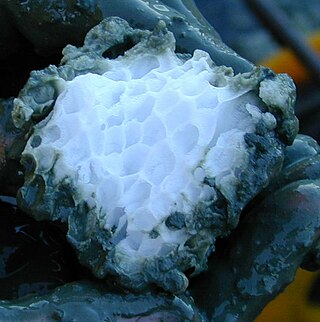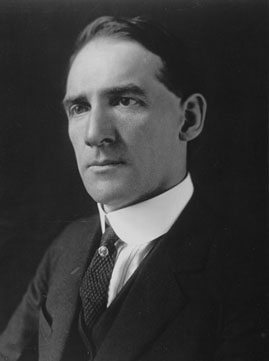
Clathrate hydrates, or gas hydrates, clathrates, or hydrates, are crystalline water-based solids physically resembling ice, in which small non-polar molecules or polar molecules with large hydrophobic moieties are trapped inside "cages" of hydrogen bonded, frozen water molecules. In other words, clathrate hydrates are clathrate compounds in which the host molecule is water and the guest molecule is typically a gas or liquid. Without the support of the trapped molecules, the lattice structure of hydrate clathrates would collapse into conventional ice crystal structure or liquid water. Most low molecular weight gases, including O2, H2, N2, CO2, CH4, H2S, Ar, Kr, and Xe, as well as some higher hydrocarbons and freons, will form hydrates at suitable temperatures and pressures. Clathrate hydrates are not officially chemical compounds, as the enclathrated guest molecules are never bonded to the lattice. The formation and decomposition of clathrate hydrates are first order phase transitions, not chemical reactions. Their detailed formation and decomposition mechanisms on a molecular level are still not well understood. Clathrate hydrates were first documented in 1810 by Sir Humphry Davy who found that water was a primary component of what was earlier thought to be solidified chlorine.

Sodium hydroxide, also known as lye and caustic soda, is an inorganic compound with the formula NaOH. It is a white solid ionic compound consisting of sodium cations Na+ and hydroxide anions OH−.

The chemical industry comprises the companies and other organizations that develop and produce industrial, specialty and other chemicals. Central to the modern world economy, it converts raw materials into commodity chemicals for industrial and consumer products. It includes industries for petrochemicals such as polymers for plastics and synthetic fibers; inorganic chemicals such as acids and alkalis; agricultural chemicals such as fertilizers, pesticides and herbicides; and other categories such as industrial gases, speciality chemicals and pharmaceuticals.

The Norwegian Institute of Technology was a science institute in Trondheim, Norway. It was established in 1910, and existed as an independent technical university for 58 years, after which it was merged into the University of Trondheim as an independent college.

Frederick Gardner Cottrell was an American physical chemist, inventor and philanthropist. He is best known for his invention of the electrostatic precipitator, one of the first inventions designed to eliminate air pollution—and for establishing the Research Corporation for Science Advancement, a foundation that has funded scientific research since 1912.
Miguel Angel Ondetti was an Argentine-born American chemist who first synthesized captopril, the first ACE inhibitor that was used to treat heart disease. With his co-worker, David Cushman, he won the 1999 Lasker Award for: "developing an innovative approach to drug design based on protein structure and using it to create the ACE inhibitors, powerful oral agents for the treatment of high blood pressure, heart failure, and diabetic kidney disease".
In 2017 the department was merged with the Department of Geology and Mineral Resources Engineering, forming the new Department of Geoscience and Petroleum.

The Gubkin Russian State University of Oil and Gas is a public university in Moscow, Russia. The university was founded in 1930 and is named after the geologist Ivan Gubkin. The university is colloquially known as Kerosinka, meaning 'kerosene stove'.

Sir George Thomas Beilby was a British chemist.
Vladimir Haensel was an American chemical engineer who invented the platforming process - a platinum catalytic process for reforming petroleum hydrocarbons into gasoline. In addition, he was influential in the creation of catalytic converters for automobiles.
Bruce D. Roth is an American organic and medicinal chemist who trained at Saint Joseph's College, Iowa State University and the University of Rochester, and, at the age of 32, discovered atorvastatin, the statin-class drug sold as Lipitor that would become the largest-selling drug in pharmaceutical history. His honours include being named a 2008 Hero of Chemistry by the American Chemical Society, and being chosen as the Perkin Medal awardee, the highest honour given in the U.S. chemical industry, by the Society of Chemical Industry, American section in 2013.

Hydrochloric acid, also known as muriatic acid or spirits of salt, is an aqueous solution of hydrogen chloride (HCl). It is a colorless solution with a distinctive pungent smell. It is classified as a strong acid. It is a component of the gastric acid in the digestive systems of most animal species, including humans. Hydrochloric acid is an important laboratory reagent and industrial chemical.
A water power engine includes prime movers driven by water and which may be classified under three categories:
- Water pressure motors, having a piston and cylinder with inlet and outlet valves: their action is that analogous of a steam- or gas-engine with water as the working fluid – see water engine
- Water wheels
- Turbines, deriving their energy from high velocity jet of jets, or from water supplied under pressure and passing through the vanes of a runner which is thereby caused to rotate
David R. Bryant is an internationally acclaimed organic chemist, having worked his entire thirty-nine-year 'early career' at Union Carbide. He is inventor on some ninety patents, and a recipient of the Perkin Medal. He currently is a member of Renewable Algal Energy (RAE) LLC, and is working to commercialize an algae-to-oil process utilizing RAE's patent pending technology.
Kinetic inhibitors are a new and evolving technology of a class of Low Dosage Hydrate Inhibitors (LDHI) that are polymers and copolymers. The most common of which is polyvinylcaprolactam (PVCap). These inhibitors are primarily utilized to retard the formation of clathrate hydrates. This problem becomes most prominent in flow lines when hydrocarbons and water flow through a line. The pressure and cold temperatures that could be exposed to the flow lines provides an environment in which clathrate hydrates can form and plug up the flow line. The inhibitors generally slow the formation of the hydrates enough so the fluid reaches storage without causing blockage.

Ralph Landau was a chemical engineer and entrepreneur active in the chemical and petrochemical industries. He is considered one of the top fifty foundational chemical engineers of the first half of the 20th century, and one of the 75 most distinguished contributors to chemical enterprise. He has published extensively on chemical engineering and holds a significant number of patents.

Ganapati Dadasaheb Yadav is an Indian chemical engineer, inventor and academic, known for his research on nanomaterials, gas absorption with chemical reaction and phase transfer catalysis. He served as the vice chancellor of the Institute of Chemical Technology, Mumbai from 2009 until November 2019. He is currently the Emeritus Professor of Eminence at ICT Mumbai.
Oilfield scale inhibition is the process of preventing the formation of scale from blocking or hindering fluid flow through pipelines, valves, and pumps used in oil production and processing. Scale inhibitors (SIs) are a class of specialty chemicals that are used to slow or prevent scaling in water systems. Oilfield scaling is the precipitation and accumulation of insoluble crystals (salts) from a mixture of incompatible aqueous phases in oil processing systems. Scale is a common term in the oil industry used to describe solid deposits that grow over time, blocking and hindering fluid flow through pipelines, valves, pumps etc. with significant reduction in production rates and equipment damages. Scaling represents a major challenge for flow assurance in the oil and gas industry. Examples of oilfield scales are calcium carbonate (limescale), iron sulfides, barium sulfate and strontium sulfate. Scale inhibition encompasses the processes or techniques employed to treat scaling problems.

Praveen Linga PhD, a chemical engineer, is a professor at the National University of Singapore's Department of Chemical and Biomolecular Engineering. He is an expert in clathrate hydrates or gas hydrates. He is also the co-founder of NewGen Gas Pte Ltd, a spin-off company that specialises in solidified natural gas (SNG) technology via clathrate hydrates for natural gas storage and transport. He has been interviewed and has provided expert opinion and commentary in the media.

Sylvia Marie Stoesser, was an American chemist. She was the first woman to be employed as a chemist at Dow Chemical Company. During her time at Dow, she made a number of major contributions, holding more than two dozen patents as a result of her research.












